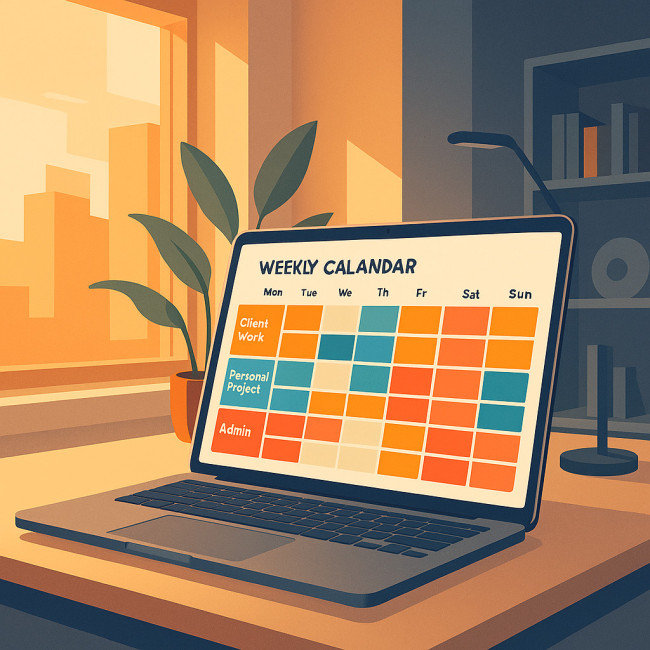Balancing client work and personal projects: a 2025 roadmap for growth
Juggling paid briefs and self-initiated ideas is the fastest way to stay solvent while sharpening your edge as a creative. This 2025 roadmap breaks down concrete tactics, time benchmarks and mindset shifts so you can balance client work and personal projects without burning out.
Why striking the balance is mission-critical in 2025
Algorithms evolve, client tastes swing, and new tools appear every quarter. A steady flow of commissioned work keeps the lights on, but your personal projects are the R&D lab that pushes style, expands your portfolio and attracts premium briefs. The two streams feed each other—yet compete for the scarcest resource you own: time.
The double payoff
- Financial resilience – client retainers cover fixed costs and let you experiment without panic.
- Creative differentiation – personal work showcases range and thought leadership, opening doors to higher-fee, values-aligned clients.
Audit your current workload
Start with a cold, data-driven look at your calendar. Track every hour for two weeks: billing, pitching, admin, research, learning and untracked “inspiration scrolls.” Use a simple sheet or a lightweight tracker like Toggl. The goal is to surface hidden drains that steal time from passion work.
Red flags to watch for
- Less than 10 % of weekly hours invested in self-initiated exploration.
- Administrative tasks ballooning past two hours a day.
- Project overlap causing context switching every 15 minutes.
Design a 50-30-20 time model
A proven starting ratio in 2025 creative studios looks like this:
Source : Freelance Report 2025
Adjust percentages to your income targets and creative ambitions, but defend a minimum 30 % block for personal projects if you want to evolve.
Build a time-blocking engine

Reserve fixed, recurring blocks for each activity. For instance, Tuesday and Thursday 8-12 a.m. becomes sacred personal-project time. Tools like Google Calendar or Motion can auto-shield those slots. For deeper inspiration explore time-blocking methods musicians rely on; the principles translate to any discipline.
Context batching hacks
- Email windows – process messages at 11 a.m. and 4 p.m. only.
- Client calls day – cluster meetings every Wednesday.
- Learning sprint – binge tutorials Friday afternoons when focus dips.
Choose personal projects that compound
Not every idea deserves six months. Evaluate using a simple matrix:
| Criteria | High-leverage project | Low-leverage project |
|---|---|---|
| Portfolio relevance | Demonstrates a style clients request | Unrelated to paid niche |
| Skill stretch | One new tool or method | No clear learning goal |
| Visibility multiplier | Easy to share as a case study | Hard to explain value |
| Timeline | < 6 weeks | Indefinite |
Automate low-value tasks
Bots and templates free hours. Use Zapier to file receipts, Calendly for bookings and Notion formulas for quick project quoting. For creatives shipping video, the Artfolio videography training hub lists ready-made templates that cut editing time by 20 %.
Price client work to fund personal R&D
Undercharging forces you to chase too many small jobs. Calculate a minimum viable rate that covers both billables and your non-billable growth time. If your calendar is full yet savings are thin, raise fees by 15 % next proposal and monitor churn—most pros retain 90 % of clients after a moderate increase.
Anchor premium pricing with social proof
Convert successful self-initiated pieces into concise case studies. One vision-driven project often convinces a brand faster than five average portfolio shots. Need help crafting succinct stories? Study the techniques in micro-writing challenges for sharp narrative hooks.
Collaborate wisely
Joint passion projects accelerate learning and split costs. Draft a lightweight memo covering scope, credit and revenue share. For more collaboration safeguards consult IP protection basics for creative duos.
Measure and iterate
Set quarterly OKRs: hours invested, portfolio pieces published, leads generated. Review analytics monthly. Drop what underperforms, double down on what converts. The habit mirrors tips in self-directed learning roadmaps—data beats guesswork.
Quick self-assessment quiz
FAQ
- How do I refuse extra client work without harming relationships?
- Offer alternative dates, recommend a trusted peer, and highlight quality focus. Clients respect boundaries when framed around better results.
- Which tools track personal-project ROI?
- Combine Google Analytics for traffic, Airtable for milestone logging, and a simple spreadsheet to link time spent to leads generated.
- What if my passion project turns into paid work mid-way?
- Re-scope with a clear contract addendum. Preserve creative freedom by carving out time for experimentation within the commercial deliverables.
Next steps
- Block two four-hour sessions this week solely for passion work.
- Create a one-page brief for your highest-leverage idea.
- Raise your next client quote by at least 10 % to fund R&D.
Ready to align income and inspiration? Start applying the roadmap today and watch both your bank balance and creative voice grow in 2025.











